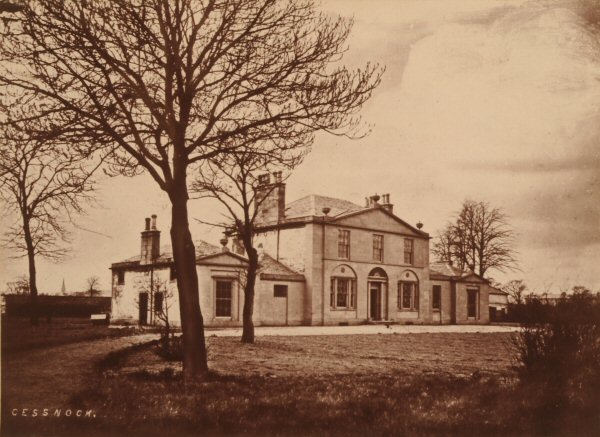

CESSNOCK is situated in the parish of Govan and county of Lanark, and is about three miles from the Cross of Glasgow.
About the middle of last century the lands of Heathriehall belonged to James Rowan. The Rowans were an old Govan family, and their estate seems to have been one of the small properties which were formed out of the church lands in this parish in the end of the sixteenth century.
In the year 1800 Andrew Hunter, manufacturer in Glasgow, bought about eleven acres of this property from Dorothea Rowan, who had succeeded her father James Rowan, and who was the wife of William Gray, merchant in Glasgow. This part of Heathriehall was called Cessnock. Immediately after acquiring it Andrew Hunter built the present house. (1)
Andrew Hunter and his brother William, (2) with whom he was in partnership, were nearly related to William and John Hunter of Long Calderwood, the celebrated brothers, who both attained to such eminence, and who respectively founded the Hunterian Museum of Glasgow and the Museum of the College of Surgeons in London. Joanna Bailie, the dramatist and poetess, and Dr. Matthew Bailie, the famous surgeon of London, were cousins of Andrew and William Hunter.
The Hunters' place of business was at the corner of the Saltmarket and the Trongate, and their firm was A. & W. Hunter.
After Andrew Hunter's death Cessnock has not been inhabited by any of the family.
He left a son, Captain Hunter, who went into the army early in life, and left three sons, of whom the only survivor is Colonel Fitzwilliam Frederick Hunter, now commanding the Brigade Depot at Worcester. This officer served during the whole of the Crimean war in the 47th Regiment, and was wounded in one of the battles. For his services there he received a brevet majority, and a medal and three clasps : he was made by the French Emperor a Knight of the Legion of Honour : and the Sultan granted him the Medjidie and a Turkish medal.
Cessnock, since the Hunters left it, has been the residence of different families. The first tenant was the late Andrew Mitchell, of the well known firm of Grahame & Mitchell, writers in Glasgow. He lived there for ten years, (3) and built the two wings shown in the photograph. He was probably attracted to Cessnock by its vicinity to Shieldhall, the residence of the family of his wife, Lilias Oswald. (4) A later tenant was William Dunlop, a retired Captain of the East India Company's Service, a brother of Mr. Dunlop of Annanhill in Ayrshire. He died very suddenly at Troon when preparing to bathe.
After many changes of occupants, Cessnock was sold by the Hunters in 1868 to John Robertson, manufacturer in Glasgow, who shortly afterwards resold it to its present owners, the Clyde Trustees. The benevolent Mr. Quarrier, of Glasgow, now rents it as a House of Refuge for the boys whom he rescues from the gutters of the city.
This property gives a good illustration of the rise in value of land in the neighbourhood of Glasgow. In 1800 Andrew Hunter paid about £1,800 for it. In 1830 it was exposed for sale at the upset price of £3,800, but was not sold. In 1868 it was sold for £12,000, and, in 1870, for about £26,000.
(1) Andrew Hunter lived in a house in St. Enoch Square before he built Cessnock. This house is still in the possession of his descendants. It is now occupied by "His Lordship's Larder."
(2) William Hunter was the owner of Greenhead in this parish. He married, and had two sons and two daughters. Andrew, his eldest son, was a manufacturer in Glasgow, and left a numerous family, some of whom survive: one of his grandsons is a medical man at Innellan. William entered the Coldstream Guards as surgeon in February 1814. He was present at the blockade of Bayonne in 1814, and served during the campaign of 1815, including the battle of Waterloo. He became Surgeon-Major, and resided at Woodbank, Largs. He married Ellen, the favourite sister of the late celebrated painter, Sir David Wilkie. R.A. She died 3rd February 1870. He survived her for some years, and was one of the last "Waterloo men" connected with Glasgow.
(3) It is worthy of note in illustration of the loneliness, forty or fifty years ago, of the Govan Road (which may now be considered one of the Glasgow streets) that an old citizen who lived near Cessnock during Mr. Mitchell's residence there, used to tell that, when they happened to be late at business, Mr. Mitchell and he had an arrangement to meet and walk down together for mutual protection.
(4) Andrew Mitchell had three sons, all citizens of Glasgow, Andrew Mitchell, Alexander Oswald Mitchell, and John Oswald Mitchell, and three daughters - Margaret (died 1877), married to the Rev. William Acworth, Vicar of South Stoke, Somerset; Alice, married to the late Donald Mackenzie, advocate (Lord Mackenzie); and Lilias, married to Lieut-General John Ramsay Stuart, C.B. Mr. A. O. Mitchell, who died in 1875, was in his father's old firm (now Mitchells, Cowan & Johnstone). He was an able and indefatigable man of business, an accomplished conveyancer, and equally at home in railway and parliamentary practice. For many years he mainly gave himself to this difficult branch of the profession, and with great success. Whatever he did he did thoroughly; and it used to be said of him that he had never lost a Bill on Standing Orders - more, probably, than could be said of any one else in as large practice.
Back to Contents